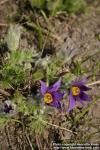Anemone Patens.—American Pulsatilla.


 Related entries: Anemone Nemorosa.—Wind Flower - Pulsatilla (U. S. P.)—Pulsatilla
Related entries: Anemone Nemorosa.—Wind Flower - Pulsatilla (U. S. P.)—Pulsatilla
The flowering plant Anemone patens, Linné; var. Nuttalliana, Gray. (Anemone Ludoviciana Nuttall; Anemone Nuttalliana, De Candolle; Pulsatilla Nuttalliana, Sprengel).
Nat. Ord.—Ranunculaceae.
COMMON NAMES: American pulsatilla, Pasque flower.
ILLUSTRATION: Drugs and Medicines of North America, by J. U. and C. G. Lloyd, Vol. I, p. 27; Meehan's Native Flowers, 1, 49.
Botanical Source and History.—"Anemone patens is a very conspicuous flower in early spring, found in prairie regions of Illinois, thence west to the Rocky Mountains, and northwest. The stem rises about 4 inches out of the ground, and is terminated by a large, erect, solitary, light bluish-purple flower. Below the flower, encircling the stem, is a many-parted floral leaf, covered with silky hairs, as are all parts of the plant. The true leaves are not expanded at flowering time, but are afterwards developed from the root of the plant, and are palmately divided into many linear lobes. The fruit is a head of achenes, with long, silky tails. It is borne on a stalk which is greatly elongated after the plant has flowered " (C. G. Lloyd, in Drugs and Medicines of North America, Vol. I, 26).
The plant has a faint, camphor-like odor, and a somewhat saccharine taste in the dried flowers; the recent flowers and leaves are very acrid and irritating, which properties are considerably lessened by drying, owing to the evaporation of a volatile, acrid principle. The fresh plant will vesicate, and the vapors of the fresh juice have produced severe conjunctivitis. Simple contact with the plant produces severe irritation. The drug was introduced to the profession by Dr. W. H. Miller, and F. B. and A. W. Miller (sons), all of St. Paul, Minn. It was introduced to Dr. Miller by an Indian, who declared it the "great medicine" of the Northwestern tribes of Indians. This plant bids fair to supplant foreign pulsatilla in the American drug market (Drugs Medicines of North America, Vol. I, 28).
Chemical Composition.—Mr. A. W. Miller (1862), proved the existence of a volatile acrid principle in this plant, and by agitating the aqueous distillate with chloroform he obtained an acrid white principle which he believed to be anemonin, though the amount was too small for verification. His brother, Mr. F. B. Miller, re-examined the plant in 1873, and by the same process obtained white, feathery crystals of a neutral reaction at first, but becoming both acid and colored in a few days. A distillate of the fresh juice preserved in alcohol was also distilled by him, and treated with chloroform, from which brown acid crystals were obtained. A quantity of the dried herb was then distilled, and subsequently treated with chloroform, as above, without obtaining the acrid principle yielded by the fresh herb. Hence, it seemed conclusive that the anemonin is dissipated in drying, and this also appears true from the fact that the dried herb has none of the irritating properties of the fresh plant, and upon chewing the herb a year old only a slight tingling sensation was produced. In fact it was scarcely more than astringent. Glucose, tannin, two resins, pectin, calcium and magnesium salts, sulphates, and the ordinary plant constituents were also found by Miller. Albumen was absent (see Prof. J. U. Lloyd, Drugs and Medicines of North America, Vol. I, 29). For further details on constituents, see Anemone nemorosa.
Action, Medical Uses, and Dosage.—This plant has been found useful in many chronic cases of ophthalmic maladies, as cataract, amaurosis, and corneal opacity; also in cutaneous eruptions and secondary syphilitic diseases. It has likewise effected cures in uncomplicated amenorrhoea, leucorrhoea, pains in the testes, or ovaries, and along the spermatic chord, sharp, cutting gastric pains, frontal headache in onanists, and in chronic irritation of the nerves. It will also be found useful in reflex paralysis, obstinate hiccough, chorea, and in chronic mucous diseases generally. The foregoing statements constitute a summary of the uses of the drug as gleaned from European and early American observers and are the cases in which large doses were employed. Many of these statements, however, require confirmation. According to Dr. W. H. Miller, it is a good pile remedy (Drugs and Medicines of North America). Prof. Edwin M. Hale, the distinguished homoeopathist, found upon investigation, that its properties were practically identical with those of European pulsatilla. (See Drugs and Medicines of North America, for homoeopathic uses). This is undoubtedly the drug referred to by Prof. H. T. Webster (Dynam. Therap.), as "Pulsatilla Nuttalliana," or "Anemone nemorosa." Owing to its probable identity with pulsatilla, this drug will undoubtedly prove a reliable substitute for the European species, and be used for similar purposes and in the same doses (see Pulsatilla). The U. S. P. (1880), recognized it as a source of pulsatilla. Five to 30 drops of the tincture (℥viij to alcohol Oj), may be added to 4 fluid ounces of water, a dose of which is a teaspoonful 3 times a day.
ANEMONIN. A solution of anemonin has been used externally in scald-head, ulcers, caries, indurated glands, venereal nodes, serpiginous affections paralysis, amaurosis, cataract, and opaque cornea. Its internal use is questionable. It has, however, been employed in bronchitis and in convulsive forms of cough, as in whooping-cough and asthma. Experiments upon the lower animals indicate that it possesses paralyzing properties, particularly directed to the cardiac and respiratory functions.

